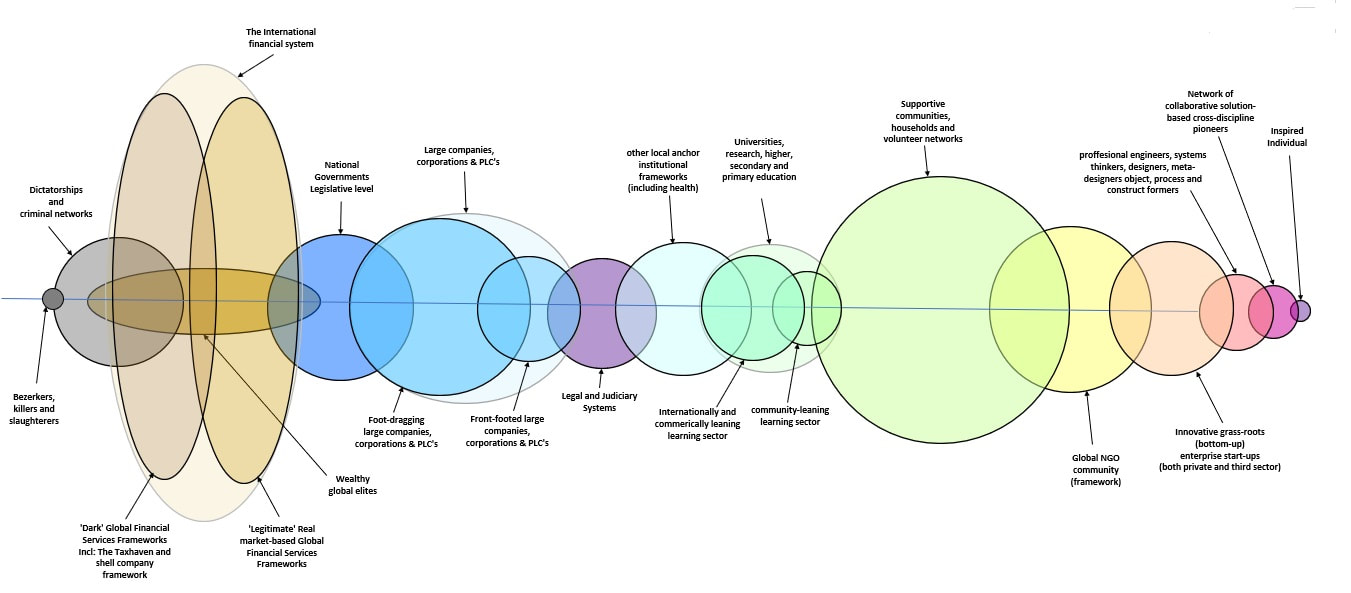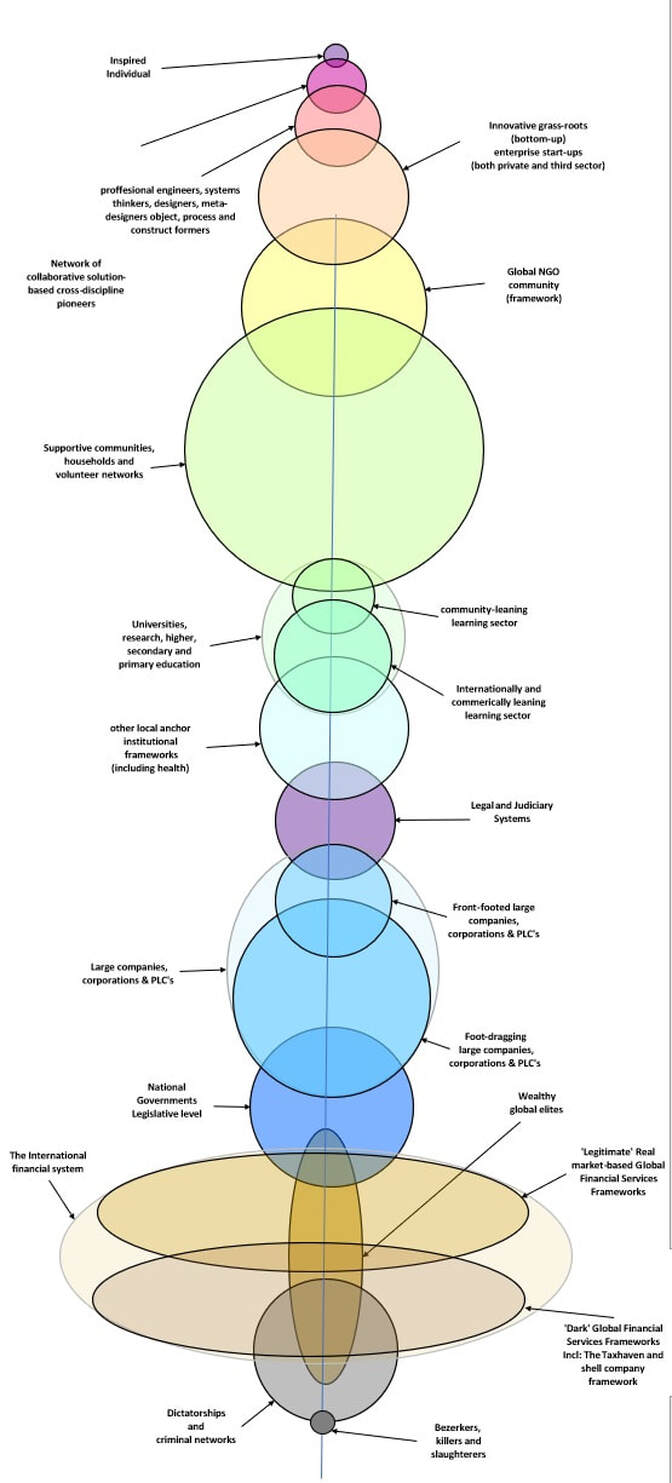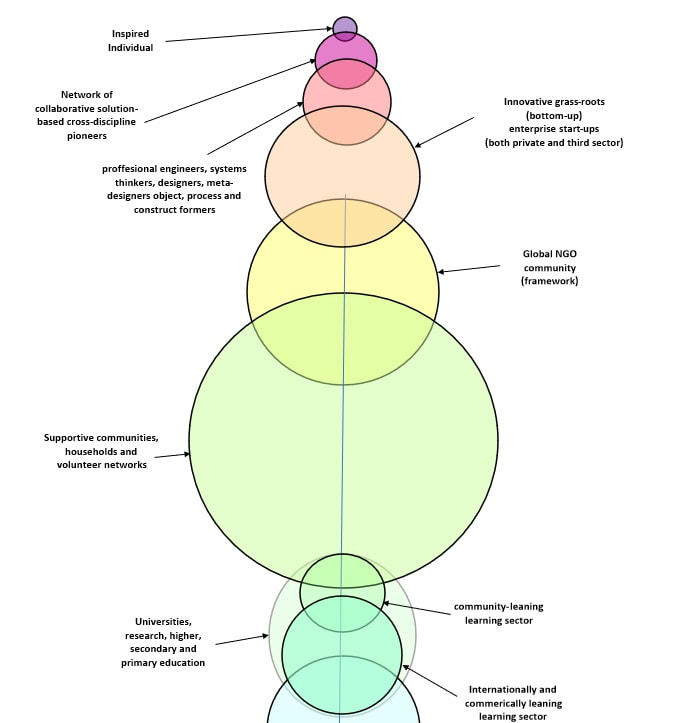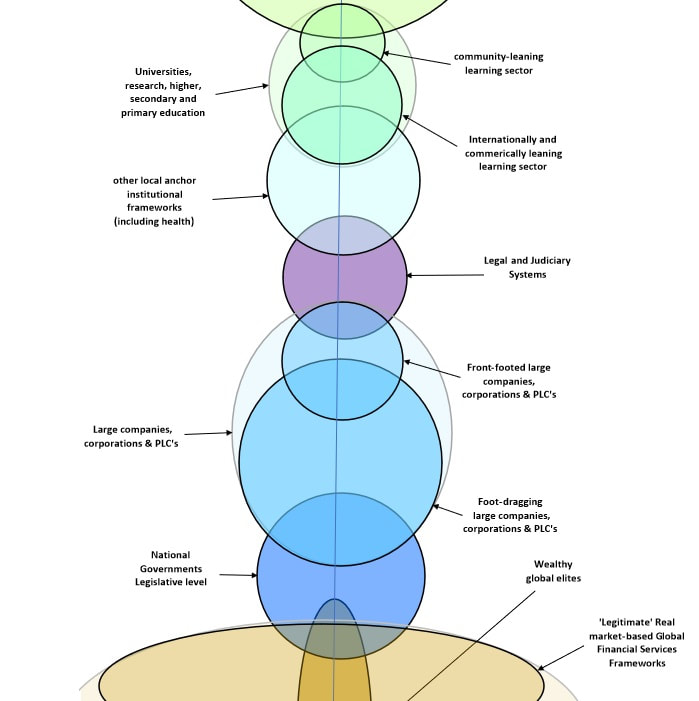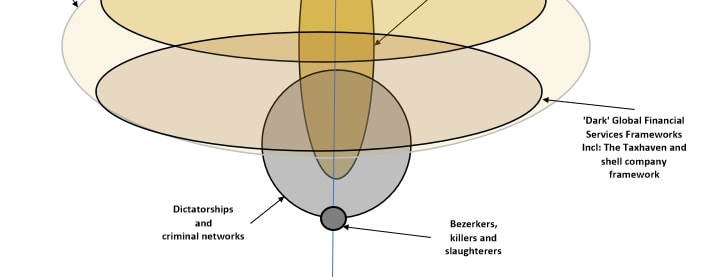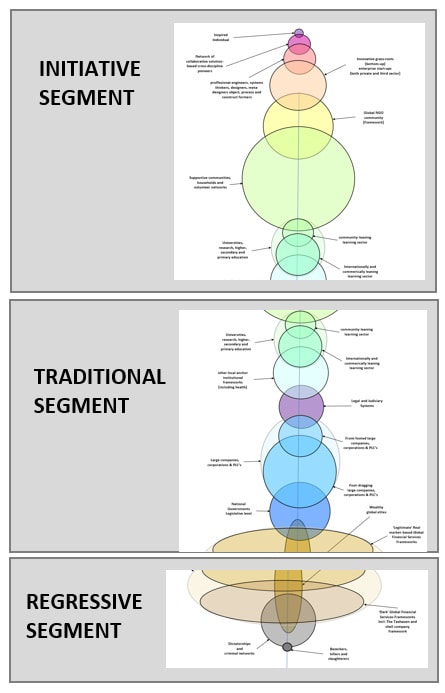Tackling the Urgent Problems of the Day:
We need a new way of understanding and engaging with organisations.
Michael Hallam - 05 July 2022
We need a new way of understanding and engaging with organisations.
Michael Hallam - 05 July 2022
It should be manifestly obvious to anyone who has decided to take the time to read this article that our global civilisation is confronted with multiple crisis in every direction one cares to look. ‘The system’, which is the sum total of all our human constructs for surviving and thriving on our planet, seems to have stalled and now appears to be imploding at an increasingly rapid rate, as the law of unappreciated consequences does its work.
Characterising the Problem
For anyone who has taken an interest in these things over the last 50 years, this should hardly come as a complete surprise. As far back as 1973, The Club of Rome was doing its own bit of projective analysis. [1] Predicting that, sometime between 2020 and 2060 the ability to grow the physical economy in the conventional way would lead to a systemic collapse of our human infrastructure, principally caused by the disruptive positive feedbacks from the planets environmental self-regulatory systems.
We have crossed a lot of those boundaries already [2] and the impactful consequences are increasingly being experienced.
And yet our global institutions and institutional frameworks still don’t appear to be up for the challenge of serious reform. Despite many global conferences, summits, pledges and initiatives there is very little evidence of any significant course correction, and the only thing that seems to be growing successfully is the abyss that is opening up before us. Sorry to be so melodramatic, I know it doesn’t help, but after a lifetime spent participating in and tracking the lack of real success of various environmental lobbying groups and alternative ways of living and ‘doing business’, it can be a bit frustrating at times.
The sad truth is that governments and many of the larger corporations are so heavily invested in the physical industrial growth paradigm, and the institutional arrangements that have grown up around that paradigm, that it is very hard for them to initiate the changes we need.
Rather than making progress, these major institutions often seem to be taking us precisely in the wrong direction. Some of you may remember the disaster movie “2012” [3]. Setting aside what a truly terrible film this was, with its wanton disregard for even the most basic laws of physics, something in that film resonates with me. The plot (sorry, spoilers) is a basic end-of world scenario where scientists inform heads of government that the end of the world is near, but they don’t bother to tell anyone else. Instead, they ally themselves with the super-rich, who provide the money to build four survival arcs and clandestinely fill them with the elite co-conspirators and the world’s most prestigious cultural artifacts. (My best moment is when they secretly take down the Mona Lisa in the middle of the night and replace it with a fake).
We actually do have a global super elite who are building themselves an alternative world that is increasingly separated from the rest of us; by gates and walls, sea that surrounds their private islands, various private transport connective routes [4] and private security teams. Maybe it’s not just because they are too myopic to see how spending some of their money on funding a sustainable infrastructure would dramatically improve our collective prospects of surviving beyond mid-century. [5] Maybe they have already given up and are quietly reinforcing and stocking up their hollowed-out survival mountains and multi-storey super-bunkers. [6]
Truth to tell, many people I know can’t afford a regular house or the rent on a one-bedroom flat, so there might just be a teensy bit of disregard for the collective wellbeing of humanity being displayed by such elitist behaviour.
This article is actually about hope and charting a way through and beyond this collective systemic disintegration, so my apologies for taking us to such a dark bleak place. However, I do think that there is a strong correlation between becoming a more effective agent for change and removing one’s rose-tinted spectacles. Curiously, I think there is a case to be made for our sense of personal agency increasing the more we realise the extent to which we are being effectively abandoned by the institutions that are meant to give our collective lives a framework of stability and predictability. [7]
Since 2010 I have been pinning my hopes on SME businesses and third sector initiatives to help turn things around and I founded The Ethical Small Traders Association (ESTA) [8] to help accelerate the process of positive change within my own community.
But I have learned that merely helping businesses and third sector organisations become better at what they do is, in itself, not enough, because the overarching frameworks that serve as the glue or template that holds human civilisation together are themselves in need of radical reform.
No single organisation, whether it is embedded in the private, public or third sector, or even groups of organisations can make any real effective change because the wider social frameworks in which they are situated is itself in need of radical reform or, to be more accurate, needs to be transcended by an evolutionary leap in collective organisational comprehension and new forms of meaningful engagement.
To envisage more clearly what I am referring to here I think that the mycelial fungal nets that saturate soil structure and provide interconnecting conduits for multiple and diverse forms of plants and animals to interconnect, thrive and exist [9] forms a good structural analogy for what I am trying to characterise. Pushing this analogy a bit further I would contend that the institutional ‘mycelial’ networks that we have underpinning our social organisational forms, which are supposed to regulate and stabilise human activity at the collective level, have been infected by ‘rogue institutional pathogens’ and increasingly unsound operational principles.
I don’t think that the collective social platforms we need really exist yet, although we can increasingly feel the need for them and can begin to identify some of the features they need to have. Meanwhile, our existing institutional platforms are increasingly not fit for purpose.
The purpose of this article is not to characterise in detail what these new structures should look like and how they operate (that will be covered in future articles) but to shift our gaze away from particular organisations and organisational forms in order to instead focus on the entire human organisational landscape.
This short article proposes an initial map or sketch of what that landscape looks like. It is designed to get us thinking and imagining what the entire human socio-economic framework, or assemblage of frameworks, looks like, with particular reference to what kind of futures various elements within this framework are driving us towards.
If we pick a point in the future, say 2050, and use our imaginative and analytical faculties to follow through on various scenarios, what kind of world might we be living in by then? I choose 2050 because that is the date used by the global scientific community as an end point for completing the transition to a zero-carbon civilisation, [10] which is one of the many things we have to do to create a fair and equitable world that takes us on a committed pathway to establishing a re-balanced relationship with the Earths environmental systems.
In the book “The Future We Choose” [11] Christiana Figueres and Tom Rivett-Carnac characterise both a utopian and a dystopian 2050 scenario, which serves as a very good reference point for the primary polar directions we do and don’t want to head towards. I think this provides a very good imaginative starting point and clearly indicates that the future we collectively choose is going to be determined by the direction of travel that various social and institutional groupings decide to adopt or are adopting.
We currently have organisational entities that are pulling in various different directions, with reference to this 2050 ‘line’. The tension line between both these directional tendencies towards the future, forms the axis line on the full spectrum of the human social platform I will now outline.
We have crossed a lot of those boundaries already [2] and the impactful consequences are increasingly being experienced.
And yet our global institutions and institutional frameworks still don’t appear to be up for the challenge of serious reform. Despite many global conferences, summits, pledges and initiatives there is very little evidence of any significant course correction, and the only thing that seems to be growing successfully is the abyss that is opening up before us. Sorry to be so melodramatic, I know it doesn’t help, but after a lifetime spent participating in and tracking the lack of real success of various environmental lobbying groups and alternative ways of living and ‘doing business’, it can be a bit frustrating at times.
The sad truth is that governments and many of the larger corporations are so heavily invested in the physical industrial growth paradigm, and the institutional arrangements that have grown up around that paradigm, that it is very hard for them to initiate the changes we need.
Rather than making progress, these major institutions often seem to be taking us precisely in the wrong direction. Some of you may remember the disaster movie “2012” [3]. Setting aside what a truly terrible film this was, with its wanton disregard for even the most basic laws of physics, something in that film resonates with me. The plot (sorry, spoilers) is a basic end-of world scenario where scientists inform heads of government that the end of the world is near, but they don’t bother to tell anyone else. Instead, they ally themselves with the super-rich, who provide the money to build four survival arcs and clandestinely fill them with the elite co-conspirators and the world’s most prestigious cultural artifacts. (My best moment is when they secretly take down the Mona Lisa in the middle of the night and replace it with a fake).
We actually do have a global super elite who are building themselves an alternative world that is increasingly separated from the rest of us; by gates and walls, sea that surrounds their private islands, various private transport connective routes [4] and private security teams. Maybe it’s not just because they are too myopic to see how spending some of their money on funding a sustainable infrastructure would dramatically improve our collective prospects of surviving beyond mid-century. [5] Maybe they have already given up and are quietly reinforcing and stocking up their hollowed-out survival mountains and multi-storey super-bunkers. [6]
Truth to tell, many people I know can’t afford a regular house or the rent on a one-bedroom flat, so there might just be a teensy bit of disregard for the collective wellbeing of humanity being displayed by such elitist behaviour.
This article is actually about hope and charting a way through and beyond this collective systemic disintegration, so my apologies for taking us to such a dark bleak place. However, I do think that there is a strong correlation between becoming a more effective agent for change and removing one’s rose-tinted spectacles. Curiously, I think there is a case to be made for our sense of personal agency increasing the more we realise the extent to which we are being effectively abandoned by the institutions that are meant to give our collective lives a framework of stability and predictability. [7]
Since 2010 I have been pinning my hopes on SME businesses and third sector initiatives to help turn things around and I founded The Ethical Small Traders Association (ESTA) [8] to help accelerate the process of positive change within my own community.
But I have learned that merely helping businesses and third sector organisations become better at what they do is, in itself, not enough, because the overarching frameworks that serve as the glue or template that holds human civilisation together are themselves in need of radical reform.
No single organisation, whether it is embedded in the private, public or third sector, or even groups of organisations can make any real effective change because the wider social frameworks in which they are situated is itself in need of radical reform or, to be more accurate, needs to be transcended by an evolutionary leap in collective organisational comprehension and new forms of meaningful engagement.
To envisage more clearly what I am referring to here I think that the mycelial fungal nets that saturate soil structure and provide interconnecting conduits for multiple and diverse forms of plants and animals to interconnect, thrive and exist [9] forms a good structural analogy for what I am trying to characterise. Pushing this analogy a bit further I would contend that the institutional ‘mycelial’ networks that we have underpinning our social organisational forms, which are supposed to regulate and stabilise human activity at the collective level, have been infected by ‘rogue institutional pathogens’ and increasingly unsound operational principles.
I don’t think that the collective social platforms we need really exist yet, although we can increasingly feel the need for them and can begin to identify some of the features they need to have. Meanwhile, our existing institutional platforms are increasingly not fit for purpose.
The purpose of this article is not to characterise in detail what these new structures should look like and how they operate (that will be covered in future articles) but to shift our gaze away from particular organisations and organisational forms in order to instead focus on the entire human organisational landscape.
This short article proposes an initial map or sketch of what that landscape looks like. It is designed to get us thinking and imagining what the entire human socio-economic framework, or assemblage of frameworks, looks like, with particular reference to what kind of futures various elements within this framework are driving us towards.
If we pick a point in the future, say 2050, and use our imaginative and analytical faculties to follow through on various scenarios, what kind of world might we be living in by then? I choose 2050 because that is the date used by the global scientific community as an end point for completing the transition to a zero-carbon civilisation, [10] which is one of the many things we have to do to create a fair and equitable world that takes us on a committed pathway to establishing a re-balanced relationship with the Earths environmental systems.
In the book “The Future We Choose” [11] Christiana Figueres and Tom Rivett-Carnac characterise both a utopian and a dystopian 2050 scenario, which serves as a very good reference point for the primary polar directions we do and don’t want to head towards. I think this provides a very good imaginative starting point and clearly indicates that the future we collectively choose is going to be determined by the direction of travel that various social and institutional groupings decide to adopt or are adopting.
We currently have organisational entities that are pulling in various different directions, with reference to this 2050 ‘line’. The tension line between both these directional tendencies towards the future, forms the axis line on the full spectrum of the human social platform I will now outline.
The Platform
Our desired aim is to create a fairer and more equitable social system which is driven by a far more sustainable use of materials accompanied with a reformed economic ‘engine’. The main illustration in this article describes a sketch of the way different institutional aspects of our collective civilisation sit with regard to that set of tasks.
The circles and ellipses represent various types of social cluster, each with their own goals, purposes, drives, operating criteria, desired outcomes, effects, and impacts on the rest of the collective social system. There is a vertical axis, or spine, running from top to bottom. In terms of directionality those organisational clusters that sit highest have the most potential or are most active in driving us towards a sustainable survivable future and those that sit lowest are the ones that appear to be putting on the breaks, or even driving things backwards towards a more dystopian future.
The circles and ellipses represent various types of social cluster, each with their own goals, purposes, drives, operating criteria, desired outcomes, effects, and impacts on the rest of the collective social system. There is a vertical axis, or spine, running from top to bottom. In terms of directionality those organisational clusters that sit highest have the most potential or are most active in driving us towards a sustainable survivable future and those that sit lowest are the ones that appear to be putting on the breaks, or even driving things backwards towards a more dystopian future.
From top to bottom this is how the list of organisational constructs reads:
- Inspired Individuals
- Network of collaborative solution-based cross-discipline pioneers
- professional engineers, systems thinkers, designers, meta-designers object processors and construct formers
- Innovative grassroots (bottom-up) enterprise start-ups (both private and third sector)
- Global NGO community (framework)
- Supportive communities, households, and volunteer networks
- Universities, research, higher, secondary, and primary education providers
- Other local anchor institutional frameworks (including health)
- Legal and Judiciary Systems
- Front-footed large companies, corporations & PLC's
- Foot-dragging large companies, corporations & PLC's
- National Governments - Legislative level
- The International financial system: 'Legitimate' Real market-based Global Financial Services Frameworks
- Wealthy global elites
- The International financial system: 'Dark' Global Financial Services Frameworks, Including the tax haven and shell company framework
- Dictatorships and criminal networks
- Berserkers, killers and slaughterers
As you can see from the list, it attempts to cover the full gamut of human operational action along with a first attempt to provide a classification system of all the major types of organisational population frameworks. The size of the circles is a very approximate rendering of the population size of each group and their potential or actual effective influence, whilst the colours are added just to make the circles stand out from each other, although there is a vague attempt to run with brighter colours for the ‘higher’ groups and darker muddier colours for the ‘lower’ groups. The designation “higher” and “lower” here refers to the more active agents for sustainable change (higher) and the more active agents for increasingly disaster-ridden ‘business as usual’ (lower).
Currently, much of the focus for effective change is being aimed at national governments and large corporate bodies to do the right thing and initiate the creation of the new systems we need, if we are to have any chance of creating a more equitable and sustainable world. (The two are inextricably linked [12]) but we also know that many other groups are leading the charge, not least in that line-up are inspired individuals, community groups, third sector organisations and new and existing businesses.
Since the 2018 IPCC report (International Panel on climate Change) [13] there has been a sea change in the number of businesses globally that have recognised the need to use their resources to contribute to rising to the climate change challenge [14] Momentum for this is focussed on the United Nations 17 Sustainable Development Goals. [15] This represents real hope and suggest that increasingly responsible businesses, that look at more than just their own bottom line, are outperforming governments in helping create the kind of institutional and operational arrangements and processes we need if we are to avoid (or at least mitigate the worst effects) of multiple catastrophes. This is why SME businesses, in particular are hight up in the list.
Another group who are even higher are engineers. In fact, it is the observations and mission of the engineering group The Global Association for Transition Engineering [16] that inspired me to work on this organisational classification project. [17] They make a pretty good case for placing our hope in engineers and systems designers and, when it comes to delivering improved social and environmental value. they make good case as to why engineers have been way ahead of the legislative curve for over a century.
Currently, much of the focus for effective change is being aimed at national governments and large corporate bodies to do the right thing and initiate the creation of the new systems we need, if we are to have any chance of creating a more equitable and sustainable world. (The two are inextricably linked [12]) but we also know that many other groups are leading the charge, not least in that line-up are inspired individuals, community groups, third sector organisations and new and existing businesses.
Since the 2018 IPCC report (International Panel on climate Change) [13] there has been a sea change in the number of businesses globally that have recognised the need to use their resources to contribute to rising to the climate change challenge [14] Momentum for this is focussed on the United Nations 17 Sustainable Development Goals. [15] This represents real hope and suggest that increasingly responsible businesses, that look at more than just their own bottom line, are outperforming governments in helping create the kind of institutional and operational arrangements and processes we need if we are to avoid (or at least mitigate the worst effects) of multiple catastrophes. This is why SME businesses, in particular are hight up in the list.
Another group who are even higher are engineers. In fact, it is the observations and mission of the engineering group The Global Association for Transition Engineering [16] that inspired me to work on this organisational classification project. [17] They make a pretty good case for placing our hope in engineers and systems designers and, when it comes to delivering improved social and environmental value. they make good case as to why engineers have been way ahead of the legislative curve for over a century.
Three Principal Segments
A good enough for now working title for this schema could be something like the Scale of Ranked Influencer Populations, or the Ranked Influencer Population Scale, or the RIPS scale for short.
The purpose of this article is just to introduce this RIPS scale, so I want to leave detailed analysis to another occasion. For now, I simply offer up the RIPS as stimulus for thought and as a possible diagnostic tool.
In that regard I will conclude by sharing a little bit of my own diagnosis using the RIPS scale.
The purpose of this article is just to introduce this RIPS scale, so I want to leave detailed analysis to another occasion. For now, I simply offer up the RIPS as stimulus for thought and as a possible diagnostic tool.
In that regard I will conclude by sharing a little bit of my own diagnosis using the RIPS scale.
|
I perceive three distinct sections, or segments to the scale. The highest segment contains the most innovative groups, and it is interesting to note that virtually all of them are products of the late 20th and 21st Centuries. Universities, formal research, and the higher educational system marks a boundary point between the top and middle segments of the scale. The middle segment contains all of the systems of government and regulation that we are most familiar with when we think of any traditional form of social institutional framework; local, national and international government institutions, legal structures and traditional corporations and financial institutions. This is where we have been traditionally looking for solutions. |
|
The third segment is far more dysfunctional and contains the most undesirable organisational frameworks, namely dictatorships, criminal operations, terrorists and other regressive elements. Post 1945 we were happy to imagine that we were slowly evolving beyond such forms of activity, but events in the 21st century have clearly demonstrated that this is not the case.
The groups in the third segment seem to be actively dragging us backwards whilst the traditional institutional frameworks seem to have stalled, [18] in the face of the enormous transformation challenges we now face, coupled with their evident inability to steer us through that transformation. This makes the second segment ripe for ‘infection’ by agents sitting within the third segment. |
I would therefore characterise these three broad segments as:
Meanwhile, as some of us are only too painfully aware, the initiatives belonging to the Initiative Segment have been systematically ignored and starved or resources for the best part of half a century. Maybe the new solutions, techniques, frameworks, and perspectives that they come up with are the very things that the Traditional Segment needs in order to strengthen it against the Regressive Segment.
One final observation. I am deeply heartened to see how engineers are now self-identifying themselves as active agents for constructive change. Maybe a new recognition of each other and an alliance between the groups in the Initiative Segment can lead to an acceleration of creative constructive dialogue, ideas sharing and infrastructure construction that embraces technological development and a form of 21st Century morality based on a form of individual and group empowerment that is based upon observing and practicing what works, rather than blindly following outworn beliefs and value structures.
- The Initiative Segment
- The Traditional Segment
- The Regressive Segment
Meanwhile, as some of us are only too painfully aware, the initiatives belonging to the Initiative Segment have been systematically ignored and starved or resources for the best part of half a century. Maybe the new solutions, techniques, frameworks, and perspectives that they come up with are the very things that the Traditional Segment needs in order to strengthen it against the Regressive Segment.
One final observation. I am deeply heartened to see how engineers are now self-identifying themselves as active agents for constructive change. Maybe a new recognition of each other and an alliance between the groups in the Initiative Segment can lead to an acceleration of creative constructive dialogue, ideas sharing and infrastructure construction that embraces technological development and a form of 21st Century morality based on a form of individual and group empowerment that is based upon observing and practicing what works, rather than blindly following outworn beliefs and value structures.
We need to work towards a new practice of shared equality and sustainable practice, and not wait for the Second Segment, with its increasingly outdated legacy methodologies and moralities to step up for us. If anything, I would suggest that the healthy reform of the second organisational layer is dependent on the new initiative takers, if it is to stand any chance of not being completely dragged down by reactionary regressionism.
This article introduces a thought experiment and makes a couple of observations based upon that experiment. If we are to begin to seriously engage in the process of creating real 21st century ready organisational frameworks, then we need to start thinking beyond the skin of particular organisational forms and even clusters of organisations and start looking at the whole human organisational body as a single interconnected whole.
For this we need new conceptual and practical tools. I wonder if you agree with me.
Michael Hallam - 29 July 2022
This article introduces a thought experiment and makes a couple of observations based upon that experiment. If we are to begin to seriously engage in the process of creating real 21st century ready organisational frameworks, then we need to start thinking beyond the skin of particular organisational forms and even clusters of organisations and start looking at the whole human organisational body as a single interconnected whole.
For this we need new conceptual and practical tools. I wonder if you agree with me.
Michael Hallam - 29 July 2022
Refferences
[1] The Origin of "Limits to Growth" - Interview with Dennis Meadows – 2016 – You Tube https://www.youtube.com/watch?v=U7Z6h-U4CmI
[2] The nine planetary boundaries – Stockholm Resilience Centre
https://www.stockholmresilience.org/research/planetary-boundaries/the-nine-planetary-boundaries.html
[3] 2012 – Columbia Pictures
https://en.wikipedia.org/wiki/2012_(film)
[4] Passports for purchase: How the elite get through a pandemic https://edition.cnn.com/travel/article/buying-multiple-passports-pandemic/index.html
[5] How the rich could stop climate change https://www.newstatesman.com/environment/2022/01/how-the-rich-could-stop-climate-change
[6] Weapons rooms, fake windows and a $3m price tag: inside a luxury doomsday bunker – Guardian 01 August 2020
https://www.theguardian.com/lifeandstyle/2020/aug/01/3m-price-tag-inside-luxury-doomsday-bunker
[7] For example see: “Why We Must Talk About Institutional Corruption to Understand Wrongdoing in the Health Sector” https://www.ncbi.nlm.nih.gov/pmc/articles/PMC7306114/
[8] The Ethical Small Traders Association https://www.lancasteresta.org/
[9] More on mycelial nets: https://www.nationalforests.org/blog/underground-mycorrhizal-network
[10] Net Zero by 2050: https://royalsociety.org/whats-new/2050-challenge/
[11] The Future We Choose and the Global Optimism group: https://www.globaloptimism.com/the-future-we-choose
[12] Sustainability without equality is impossible - Ashish Kothari - 13 May 2022. https://www.meer.com/en/69636-sustainability-without-equality-is-impossible
[13] IPCC Special Report: 2018 https://www.ipcc.ch/sr15/chapter/spm/
[14] The Global Goals are in Business: 17 Global giants join forces to deliver the SDG’s: https://www.globalgoals.org/news/the-global-goals-are-in-business-17-global-giants/
[15] The UN Sustainable Development Goals https://sdgs.un.org/goals
[16] The Global Association for Transition Engineering: https://www.transitionengineering.org/
[17] Transition Engineering Genesis: Can engineering change the future? – You Tube – 13 October 2019: https://www.youtube.com/watch?v=2parGAApDBw
[18] “Why are So Many Liberal Democracies in Europe Struggling?” Ben Margulies 2016: https://www.psa.ac.uk/psa/news/why-are-so-many-liberal-democracies-europe-struggling
[1] The Origin of "Limits to Growth" - Interview with Dennis Meadows – 2016 – You Tube https://www.youtube.com/watch?v=U7Z6h-U4CmI
[2] The nine planetary boundaries – Stockholm Resilience Centre
https://www.stockholmresilience.org/research/planetary-boundaries/the-nine-planetary-boundaries.html
[3] 2012 – Columbia Pictures
https://en.wikipedia.org/wiki/2012_(film)
[4] Passports for purchase: How the elite get through a pandemic https://edition.cnn.com/travel/article/buying-multiple-passports-pandemic/index.html
[5] How the rich could stop climate change https://www.newstatesman.com/environment/2022/01/how-the-rich-could-stop-climate-change
[6] Weapons rooms, fake windows and a $3m price tag: inside a luxury doomsday bunker – Guardian 01 August 2020
https://www.theguardian.com/lifeandstyle/2020/aug/01/3m-price-tag-inside-luxury-doomsday-bunker
[7] For example see: “Why We Must Talk About Institutional Corruption to Understand Wrongdoing in the Health Sector” https://www.ncbi.nlm.nih.gov/pmc/articles/PMC7306114/
[8] The Ethical Small Traders Association https://www.lancasteresta.org/
[9] More on mycelial nets: https://www.nationalforests.org/blog/underground-mycorrhizal-network
[10] Net Zero by 2050: https://royalsociety.org/whats-new/2050-challenge/
[11] The Future We Choose and the Global Optimism group: https://www.globaloptimism.com/the-future-we-choose
[12] Sustainability without equality is impossible - Ashish Kothari - 13 May 2022. https://www.meer.com/en/69636-sustainability-without-equality-is-impossible
[13] IPCC Special Report: 2018 https://www.ipcc.ch/sr15/chapter/spm/
[14] The Global Goals are in Business: 17 Global giants join forces to deliver the SDG’s: https://www.globalgoals.org/news/the-global-goals-are-in-business-17-global-giants/
[15] The UN Sustainable Development Goals https://sdgs.un.org/goals
[16] The Global Association for Transition Engineering: https://www.transitionengineering.org/
[17] Transition Engineering Genesis: Can engineering change the future? – You Tube – 13 October 2019: https://www.youtube.com/watch?v=2parGAApDBw
[18] “Why are So Many Liberal Democracies in Europe Struggling?” Ben Margulies 2016: https://www.psa.ac.uk/psa/news/why-are-so-many-liberal-democracies-europe-struggling
